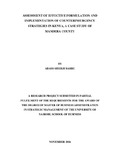| dc.description.abstract | Mandera County has suffered several cases of insurgent attacks. The prevalent insecurity threatens the achievement of the Kenya‟s Vision 2030 (KNCHR, 2014). In addition, terror attacks approximately account for 8% of deaths resulting from insecurity incidences in Kenya related to but much worse in Mandera County as it has resulted in displacement of 16% of the locals within the county (KIRA, 2014; KNCHR, 2014). It is claimed that deep-rooted discriminations and perceived or real marginalisation in Northern Kenya have provided breeding ground for support of insurgent activities by Al-Shabaab with the claim of pursing its extreme „Jihad‟ in the region and enhance their cause (Rohwerder, 2015). In addition, North Eastern Kenya bordering conflicted Somalia has spill-over effects coupled with perceived mistreatment of ethnic Somalis and local Muslims. Furthermore the response by security agents to quell the violence has largely played State security responses that are seen to target Somalis and Muslims more widely play straight into Al-Shabaab‟s strategic method to provoke a vehement insurgency in Kenya in its quest to pressure the Kenyan government to withdraw the Kenya Defence Forces from Somalia (Lind, Mutahi, & Oosterom, 2015). Although the security agencies have tried to adopt new approaches to counter the Al-Shabaab, it has been observed that the Kenyan security system has significant weaknesses (Gibbons, 2014). The security situation in the County will only be strengthened by the pursuit of interrelated political, governance and security reforms addressing violence happening at the country‟s margins and that have the greatest impacts for its marginalised populations. This study therefore sought to evaluate the effectiveness of informational, security, political and economic counter-insurgency measures deployed in Mandera County. The study employed a case study design which targeted heads of security agencies. Data was gathered through Key Informant Interviews administered to purposively sampled head of security agencies. Qualitative data collected was analysed via content where emerging themes were coded and results presented as verbatim. The results showed that there was no consolidated counterinsurgency strategy but counterinsurgents were independently implementing measures with semblance to counterinsurgency strategy. There was minimal use of propaganda among security agencies as compared to the insurgents‟ use hence reduced public image of security agencies. On the other hand security agencies were effectively providing security for locals and were able to gather intelligence as a result of collaborative community policing. Security agencies were however not involved in execution of developmental programs hence denying them an opportunity to interact with the locals. There was need to develop a single comprehensive counterinsurgency strategy to be implemented by the existing agencies to enable them better coordinate implementation. Security agencies should also enhance intelligence gathering mechanisms so as to avoid extrajudicial killings associated with leader decapitation. The study recommended that there is need for counterinsurgents to consolidate their counterinsurgency measures into one executable strategic plan. This will enable the agencies better coordinate activities as well as better information sharing hence fostering their chances of success in countering insurgency within the county | en_US |



